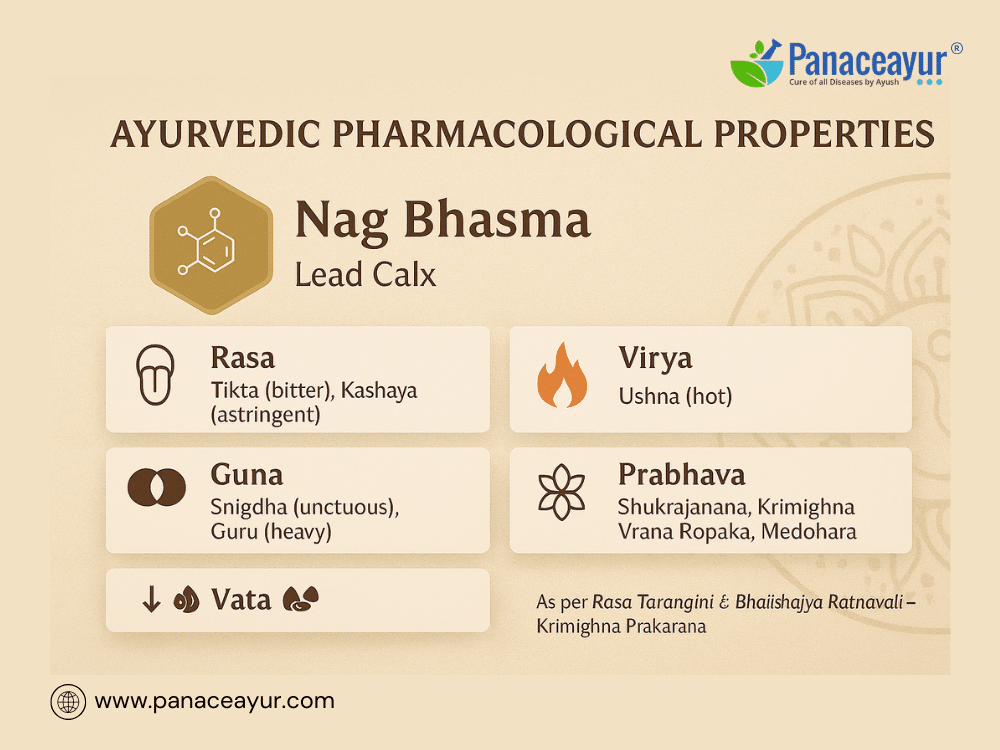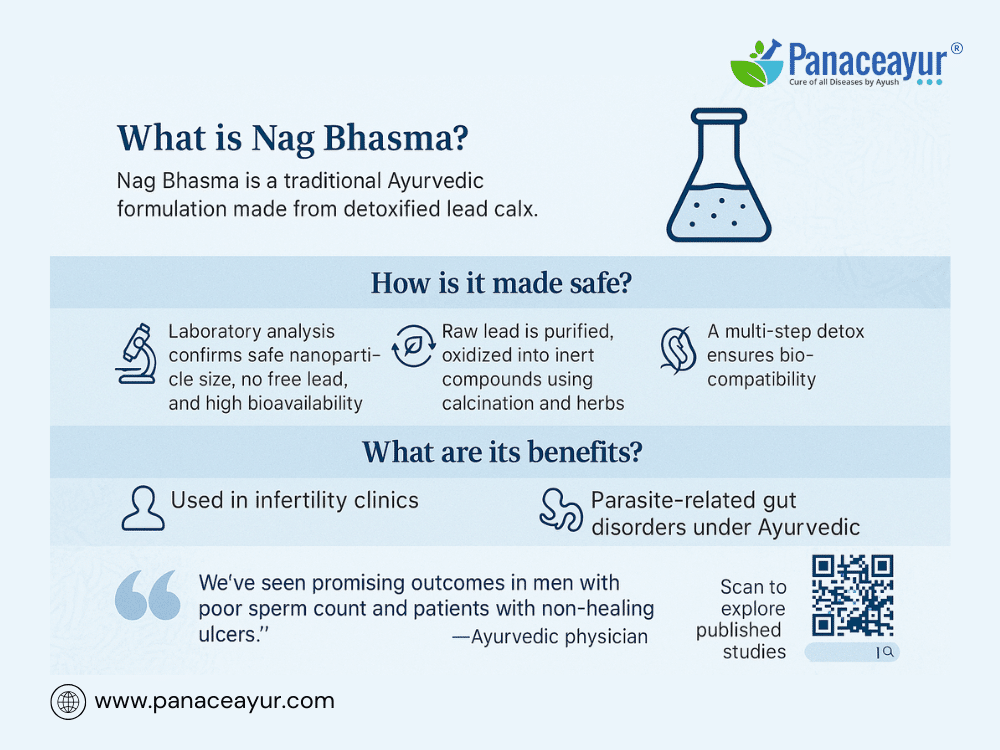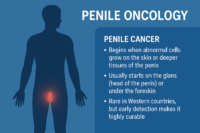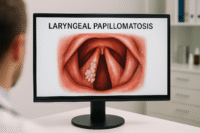Nag Bhasma, known as Lead Calx in English, is a classical Ayurvedic formulation prepared from purified lead through a complex detoxification and incineration process. It has been used for centuries in Rasashastra (Ayurvedic alchemy) for treating conditions like male infertility, metabolic imbalances, chronic ulcers, and parasitic infections [1].
Unlike raw lead, which is toxic, Nag Bhasma undergoes a series of herbal purification (Shodhana) and controlled incineration (Marana) steps that convert it into a safe, bioavailable, and therapeutic form. This transformation neutralizes the heavy metal’s toxicity and enhances its medicinal effects [2]. The final product is not metallic lead anymore—it’s a nanosized ash (bhasma) with high biological compatibility and healing potential [3].
Ayurvedic texts classify Nag Bhasma as an Uparasa (secondary mineral) and describe it as Shukra Vardhaka (enhancer of reproductive fluids), Krimighna (anti-parasitic), and Vrana Ropaka (wound healer) [4]. It’s especially valued in conditions where the reproductive, metabolic, or musculoskeletal systems are weakened.
What sets Nag Bhasma apart in traditional medicine is not just its potent effects, but the way it is tailored to the patient’s constitution (Prakriti), disease stage, and body channels (Srotas). In many cases, it’s used in combination with rejuvenating herbs like Shatavari, Guduchi, or Kapikacchu to restore deep systemic balance [5].
Today, research shows that when prepared correctly, Nag Bhasma contains bio-transformed lead oxides (such as PbO and Pb₃O₄) with no traces of free lead, making it fundamentally different from industrial or environmental lead exposure [6]. This validates the safety and efficacy of ancient Ayurvedic metallurgical science in a modern context.
In upcoming sections, we’ll explore how it’s made, how it works at the biological level, and where it stands in both classical and scientific systems of medicine.
Classical Ayurvedic References
Nag Bhasma holds a firm place in the ancient Ayurvedic pharmacopeia, backed by multiple authoritative Rasashastra and Chikitsa texts. These references don’t just mention it—they describe its specific indications, preparation methods, and therapeutic scope in detail.
In the Rasa Tarangini, a core alchemical manual, lead (Nag) is classified as an Uparasa and praised for its effectiveness in male reproductive disorders (Shukra Kshaya), chronic wounds (Dushta Vrana), and intestinal parasites (Krimi Roga) [7]. The text explains that proper purification (Shodhana) removes its toxic nature, while Marana makes it therapeutically active.
The Bhaishajya Ratnavali includes Nag Bhasma under multiple chapters, especially in:
- Rasayana Prakarana (for rejuvenation therapies),
- Krimighna Prakarana (for anti-parasitic applications), and
- Vajikarana Prakarana (for improving sexual health) [8].
Rasa Ratna Samuccaya, another classical authority, expands on the use of Nag Bhasma in regulating fat metabolism (Medo Roga), healing chronic ulcers, and enhancing sperm production [9]. It warns against improper preparation and emphasizes the role of correct herbal media (like lemon juice and garlic) during purification.
The Charaka Samhita, while not directly naming Nag Bhasma, lays the foundational philosophy for mineral medicine and supports the integration of metals into deep-acting Rasayana therapies [10].
Even the Chakradatta text, known for its practical formulations, recommends Nag Bhasma in treating Vatarakta (a gout-like disorder), suggesting its systemic anti-inflammatory and tissue-repairing potential [11].
In all these texts, one message is clear: when properly prepared, Nag Bhasma is not a toxic compound, but a powerful therapeutic agent aligned with the Ayurvedic principle of Shodhana (purification) and Samskara (transformation).
Next, we will explore the Shodhana process—how ancient Ayurveda neutralized the toxic nature of lead and made it medicinally viable.
Chemical Composition and Modern Analysis
The real magic of Nag Bhasma lies in how ancient Ayurvedic processing transforms raw lead into a non-toxic, biologically compatible therapeutic agent. Modern science confirms that the end product is no longer raw lead—it is a completely different compound, both chemically and structurally [17].
What happens to lead in the Marana process?
When lead is incinerated with herbal media and subjected to multiple Puta (incineration) cycles, it oxidizes into stable compounds such as:
- Lead oxide (PbO)
- Lead tetroxide (Pb₃O₄)
These are no longer metallic lead but chemically altered oxides that behave very differently inside the body [18].
Advanced laboratory studies using X-ray Diffraction (XRD) have confirmed the crystalline structures of PbO and Pb₃O₄ in Nag Bhasma. The diffraction peaks indicate consistent particle crystallinity, a marker of stability and therapeutic potential [19].
How small are the particles?
Modern techniques like Scanning Electron Microscopy (SEM) and Transmission Electron Microscopy (TEM) show that properly prepared Nag Bhasma particles range from 100 nanometers to 500 nanometers, placing them within the nanoscale range [20]. These ultra-fine particles allow for:
- Better absorption across gut membranes
- Cellular uptake via endocytosis
- Transport across the blood–brain barrier (when required)
This nanostructure is one reason why Nag Bhasma can act on deep tissues like the reproductive system, joints, and even chronic ulcers.
Is there any toxicity?
One of the biggest myths about Nag Bhasma is that it contains toxic lead. But modern Inductively Coupled Plasma Mass Spectrometry (ICP-MS) and Atomic Absorption Spectroscopy (AAS) studies show that there is no free lead present when the Bhasma is correctly prepared. All lead exists in bound, oxidized, or protein-conjugated forms [21].
In fact, researchers have noted that Nag Bhasma:
- Does not accumulate in the liver or kidneys
- Does not cross the toxicity threshold in animal models
- Passes easily through the body when not needed, without disrupting organs
This modern validation supports the classical Ayurvedic claim that Marana not only transforms metals but also removes their harmful properties while preserving their therapeutic power [22].
In the next section, we will dive into the Ayurvedic theory behind how Nag Bhasma interacts with the body—its taste, qualities, energetic action, and how it balances the doshas.
Ayurvedic Pharmacological Properties

In Ayurveda, every substance is analyzed not just by its chemical profile, but by how it behaves in the body—its taste (Rasa), qualities (Guna), potency (Virya), metabolic effect (Vipaka), and unique action (Prabhava). These parameters determine how a medicine balances the body’s bioenergies (doshas) and restores health.
Taste – Rasa
Nag Bhasma is primarily:
- Tikta (bitter) – helps clear toxins and parasites
- Kashaya (astringent) – tones tissues and reduces discharge or inflammation [23]
These tastes are ideal for treating conditions involving Kapha and Vata imbalance, such as metabolic sluggishness, chronic wounds, and reproductive disorders.
Qualities – Guna
Nag Bhasma exhibits:
- Snigdha (unctuous) – lubricates tissues and supports fertility
- Guru (heavy) – grounding effect on hyperactivity and over-excitation of nerves [24]
These qualities help stabilize systems affected by depletion, dryness, or irregular movement—especially in Vata-dominant disorders.
Potency – Virya
- Ushna (hot potency) – improves digestion, circulation, and breaks down metabolic blockages [25]
This makes it suitable for removing Ama (toxins) and supporting tissue regeneration.
Post-digestive Effect – Vipaka
- Katu (pungent metabolism) – promotes detoxification, supports fat metabolism, and reduces excessive mucous or fluid accumulation [26]
It helps treat chronic conditions involving stagnation, such as obesity, PCOS, or inflammatory skin diseases.
Specific Action – Prabhava
The unique action of Nag Bhasma includes:
- Shukrajanana – revitalizes sperm and reproductive fluid
- Krimighna – eliminates parasitic and microbial overload
- Vrana Ropaka – accelerates wound healing
- Medohara – reduces fat tissues and corrects metabolic errors [27]
These properties explain why classical texts recommend Nag Bhasma for conditions like infertility, chronic ulcers, PCOS, and joint degeneration.
Effect on Doshas
Nag Bhasma is known to:
- Pacify Kapha and Vata dosha
- Mildly aggravate Pitta if used excessively or without balancing herbs
Thus, it is best combined with cooling or grounding Rasayanas like Shatavari, Ghee, or Guduchi when given long term [28].
Next, we’ll explore the specific diseases and clinical conditions where Nag Bhasma has shown therapeutic value—both in classical literature and current integrative practice.
Clinical Uses of Nag Bhasma

Nag Bhasma (Lead Calx) is a traditional Ayurvedic compound used for chronic and complex conditions affecting reproductive health, metabolism, inflammation, and tissue healing. When properly purified, it becomes a safe and effective Rasayana—meaning it supports long-term rejuvenation and recovery.
Supports male fertility and sexual health
Used traditionally to treat low sperm count, erectile dysfunction, and sexual fatigue, Nag Bhasma is known to enhance vitality and reproductive fluid quality. It works best when paired with herbs like Shilajit or Mucuna pruriens (Kapikacchu) to restore hormone balance and libido.
Promotes female reproductive balance
Nag Bhasma is used in Ayurvedic medicine to manage menstrual cramps, hormonal imbalances like PCOS, and chronic vaginal discharge. When combined with uterine tonics such as Shatavari or Ashoka bark, it helps normalize cycles and enhance fertility.
Fights gut parasites and improves digestion
In Ayurvedic texts, Nag Bhasma is considered a strong anti-parasitic. It may help manage worm infestations, chronic bloating, and symptoms similar to irritable bowel syndrome (IBS). It supports gut immunity and balances digestive fire (Agni), especially when used with Triphala or Vidanga.
Heals chronic wounds and diabetic ulcers
Nag Bhasma is often used in cases of non-healing wounds, including those seen in diabetes or pressure injuries. Its wound-healing action is enhanced when taken internally with turmeric or applied topically with medicated ghee preparations.
Improves joint health and mobility
Nag Bhasma supports bone and marrow strength and may help manage joint pain, stiffness, and degeneration seen in osteoarthritis or spondylosis. Its regenerative action is enhanced when combined with herbal anti-inflammatories like Dashamoola or Ashwagandha.
Reduces prostate swelling and improves urination
For men experiencing symptoms of enlarged prostate or incomplete urination, Nag Bhasma may support bladder emptying and reduce pressure in the urinary tract. It’s traditionally paired with Varuna root or Chandraprabha Vati.
Supports weight balance and metabolic health
In cases of obesity, PCOS, or sluggish metabolism, Nag Bhasma acts on fat tissue and helps reduce buildup. It promotes detox and works synergistically with herbs like Guggulu and Triphala to support healthy body composition.
Helps reduce gout and uric acid-related joint pain
Used in traditional gout treatment (known as Vatarakta), Nag Bhasma can reduce burning pain and joint inflammation linked to elevated uric acid. It’s best paired with anti-inflammatory herbs like Guduchi or Manjistha.
May help with hernia-related discomfort
Ayurvedic doctors sometimes use Nag Bhasma for abdominal strain, umbilical hernias, or inguinal hernias. It is typically administered along with herbs that relax intestinal spasms and reduce Vata in the pelvic area.
Supports red blood cell production in anemia
When combined with iron-rich Bhasmas or Punarnava, Nag Bhasma is used to treat chronic anemia, fatigue, and low energy. It helps strengthen the blood and improve nutrient assimilation.
Reduces fluid retention and inflammatory swelling
Nag Bhasma has traditionally been used in conditions like edema or swelling caused by inflammation or kidney weakness. It promotes natural detoxification and lymphatic flow, especially when paired with diuretics like Punarnava.
Useful in hemorrhoids and rectal swelling
In painful or bleeding piles (hemorrhoids), Nag Bhasma may help reduce local inflammation and bleeding. It is generally used with astringent herbs and constipation-relieving compounds.
Supports healing in anal fistulas
In chronic fistula-in-ano, Nag Bhasma is included in internal and topical treatments. It supports tissue healing and works well with ghee-based herbal oils like Jatyadi.
Helps manage skin conditions like eczema or psoriasis
When used with blood-purifying herbs, Nag Bhasma may support the healing of chronic skin disorders. It helps cleanse the deeper tissues and is often paired with Manjistha or Khadira.
Has calming effects in epilepsy-like symptoms
In Ayurveda, it’s sometimes used for seizure-prone individuals to reduce nervous agitation. It has a grounding and stabilizing effect when used with herbs like Brahmi or Ashwagandha.
Improves chronic diarrhea and gut absorption
For long-standing IBS or malabsorption issues, Nag Bhasma may help by strengthening digestive fire and rebuilding tissue tone. It’s often given with Bilva or Kutaj bark powder.
Supports healthy blood sugar levels in early diabetes
When taken with insulin-sensitizing herbs like Shilajit or Gymnema (Meshashringi), Nag Bhasma may help manage symptoms in early-stage type 2 diabetes. It reduces excess urination and sweet cravings.
Helps prevent urinary stone formation
Nag Bhasma may help dissolve small urinary stones and prevent recurrence. Used with diuretic and stone-breaking herbs like Gokshura or Varuna, it supports kidney health.
Aids in fluid-related abdominal disorders
In conditions resembling ascites or liver-related bloating, Nag Bhasma supports metabolism and reduces excess fluid. It’s traditionally used with bitter tonics and mild diuretics.
Dose and Anupana
Nag Bhasma is a potent Ayurvedic mineral formulation and must be taken under the supervision of a qualified practitioner. Its dose varies based on the condition being treated, the strength of digestion (Agni), and the individual’s constitution (Prakriti).
Standard therapeutic dose
The typical adult dose ranges from 30 mg to 125 mg once or twice daily. In some Vajikarana (rejuvenation and fertility) protocols, it may be increased cautiously under medical guidance.
Best taken with a suitable Anupana (carrier)
In Ayurveda, each Bhasma is paired with a specific liquid or herb to enhance absorption and target effect. Anupana varies based on disease:
- For infertility and sexual weakness: Warm milk + Shatavari or Kapikacchu powder
- For gut parasites or IBS: Warm water + Vidanga or Triphala Churna
- For chronic ulcers or skin issues: Honey + turmeric (Haridra) or neem
- For arthritis or joint degeneration: Ghee + Dashamoola or Ashwagandha
- For urinary and prostate issues: Varunadi Kwatha or Chandraprabha Vati
- For obesity or PCOS: Triphala decoction or warm water on empty stomach
- For anemia: Punarnava Mandoor or Mandura Bhasma + honey or Draksha juice
How long can you take it?
- For acute conditions (e.g., parasites or UTI): 2–6 weeks
- For chronic conditions (e.g., arthritis, fertility, skin): 2–3 months
- Always followed by a gap or supportive Rasayana therapy after the course
Should it be taken before or after meals?
- For digestion and metabolism: On an empty stomach or before meals
- For Rasayana and tissue building: After meals, combined with ghee or milk
Important safety reminders
- Never exceed dosage or self-administer without guidance
- Should be prescribed after proper Shodhana and Marana validation
- Use lab-tested Bhasma only (free from unconverted metallic lead)
- Avoid during pregnancy, breastfeeding, and in children
- Herbal Support: Nag Bhasma is often combined with other Ayurvedic herbs like Punarnava, Gokshura, and Varuna, which help support kidney health, reduce inflammation, and promote healthy urine flow.
- Dietary Adjustments: Ayurvedic practitioners typically recommend a diet that avoids spicy, salty, or acidic foods to prevent aggravation of Pitta dosha, which is often associated with urinary disorders. Including light, cooling foods like cucumber, watermelon, and coconut water can help soothe the urinary system.
Expected Benefits:
- Reduces Inflammation: Nag Bhasma helps reduce inflammation in the urinary tract, which is beneficial for conditions like UTIs or cystitis.
- Promotes Detoxification: It supports the detoxification of the kidneys and bladder, improving urine flow and removing toxins.
- Balances Doshas: By balancing Vata and Pitta doshas, Nag Bhasma restores urinary system function and prevents recurrent infections.
- Improves Kidney Function: Regular use of Nag Bhasma can enhance kidney function and prevent complications such as kidney stones or chronic kidney disease.
Curing Spleen Enlargement
Spleen enlargement, also known as splenomegaly, occurs when the spleen becomes larger than its normal size. The spleen is an important organ located in the upper left side of the abdomen, under the ribcage. It plays a crucial role in filtering blood, recycling old red blood cells, and helping the immune system by storing white blood cells and platelets. However, when the spleen becomes enlarged, it may indicate an underlying health problem that requires medical attention.
- Infections:
- Viral Infections: Conditions such as mononucleosis (caused by the Epstein-Barr virus) can lead to spleen enlargement.
- Bacterial Infections: Tuberculosis and other bacterial infections may cause the spleen to swell.
- Parasitic Infections: Malaria and toxoplasmosis are parasitic infections that can lead to splenomegaly.
- Liver Diseases:
- Cirrhosis: Liver scarring caused by alcohol abuse, viral hepatitis, or other liver diseases can lead to spleen enlargement.
- Portal Hypertension: Increased pressure in the veins connected to the liver can cause the spleen to swell.
- Blood Disorders:
- Hemolytic Anemia: This condition causes the body to destroy red blood cells faster than they can be replaced, leading to an enlarged spleen.
- Sickle Cell Disease: Abnormal red blood cells can block blood flow, causing the spleen to work harder and become enlarged.
- Cancers:
- Leukemia: Cancer of the blood-forming tissues, including the spleen, can cause it to enlarge.
- Lymphoma: Cancers of the lymphatic system, like Hodgkin’s or non-Hodgkin’s lymphoma, can lead to splenomegaly.
- Inflammatory Diseases:
- Rheumatoid Arthritis: Certain autoimmune diseases like rheumatoid arthritis can cause inflammation, leading to an enlarged spleen.
- Sarcoidosis: An inflammatory disease that can affect multiple organs, including the spleen.
- Congestion or Blood Clots:
- Splenic Vein Thrombosis: Blood clots in the veins connected to the spleen can lead to its enlargement.
Symptoms of Spleen Enlargement:
- Abdominal Pain or Fullness: Discomfort or pain in the upper left abdomen, which may spread to the left shoulder.
- Feeling Full Quickly: An enlarged spleen may press against the stomach, making you feel full after eating small amounts.
- Fatigue: Caused by the spleen filtering out an excessive number of blood cells.
- Anemia: A decrease in red blood cells may occur due to the spleen’s overactivity.
- Frequent Infections: The spleen may trap too many white blood cells, weakening the immune system.
- Easy Bruising or Bleeding: The spleen may filter out too many platelets, leading to blood clotting issues.
Diagnosis:
- Physical Examination: A doctor can often feel an enlarged spleen during a physical exam.
- Blood Tests: Blood tests can reveal abnormalities in red or white blood cell counts, which may point to an underlying condition.
- Imaging Tests: Ultrasound, CT scans, or MRI can provide detailed images of the spleen to determine its size and possible causes of enlargement.
- Bone Marrow Tests: In cases of blood disorders or cancers, a bone marrow biopsy may be required.
Cure for Spleen Enlargement
Nag Bhasma For Treating Spleen Enlargement
- Adults:
- Typical Dosage: 30 mg to 125 mg of Nag Bhasma, taken once or twice daily depending on the severity of spleen enlargement and the individual’s overall health condition.
- Administration: Nag Bhasma is generally taken with honey, ghee, or warm water to improve its absorption and effectiveness. Honey is often preferred due to its ability to complement the detoxifying and anti-inflammatory properties of Nag Bhasma.
- Children:
- Dosage for children is much lower (around 15 mg to 60 mg) and should be strictly administered by an Ayurvedic physician.
When to Take Nag Bhasma:
- Morning and Evening: It is often recommended to take Nag Bhasma twice a day, once in the morning and once in the evening, preferably on an empty stomach to enhance its efficacy in addressing spleen-related issues.
- Dietary Considerations: During the treatment of spleen enlargement, it is advised to avoid heavy, oily, or spicy foods that can aggravate Pitta and Kapha doshas. Light, cooling foods such as leafy greens, fruits, and adequate hydration are encouraged to support the healing process.
Duration of Treatment:
- Short-Term Use: For mild spleen enlargement, the treatment may last a few weeks to a couple of months, depending on the individual’s response to the remedy.
- Long-Term Use: For chronic or more severe cases, long-term use of Nag Bhasma may be necessary, with regular monitoring by an Ayurvedic physician.
Complementary Treatments:
- Herbal Support: Nag Bhasma is often used in combination with other Ayurvedic herbs like Punarnava, Giloy, and Triphala, which are known for their spleen-supporting, detoxifying, and anti-inflammatory properties.
- Lifestyle Adjustments: Ayurveda emphasizes the importance of a balanced lifestyle, including stress reduction techniques such as yoga and meditation, which support the healing process.
Precautions:
- Consultation Required: Always use Nag Bhasma under the guidance of an experienced Ayurvedic doctor due to the presence of purified lead. The treatment should be tailored to the individual’s specific condition and constitution.
- Avoid Overuse: Stick to the recommended dosage as overuse can lead to lead toxicity, which may cause serious health issues.
- Regular Monitoring: Follow-up visits with an Ayurvedic practitioner are essential to monitor the progress and adjust the dosage if needed. Blood tests or imaging might be recommended to track the spleen’s recovery.
Expected Benefits:
- Reduction of Spleen Size: Nag Bhasma helps reduce the size of the enlarged spleen by addressing inflammation and improving blood circulation.
- Improved Digestion and Detoxification: It promotes better digestion and assists the body in eliminating toxins that may contribute to spleen-related issues.
- Strengthened Immunity: Regular use helps boost the immune system, allowing the body to recover faster from infections or disorders that may cause spleen enlargement.
Curing Stomach Enlargement
Stomach enlargement can occur due to various reasons such as poor digestion, excessive gas, or underlying medical conditions. Nag Bhasma helps by promoting digestion, reducing inflammation, and detoxifying the body.
What is stomach enlargement?
Stomach enlargement, also known as abdominal distention or bloating, occurs when the abdomen becomes noticeably swollen or larger than usual. This condition is typically caused by the accumulation of gas, fluid, or other substances in the stomach or intestines, resulting in discomfort or a visible increase in abdominal size.
Causes of Stomach Enlargement:
- Gas and Bloating:
- Indigestion: Overeating or consuming certain foods (such as beans, carbonated drinks, or fatty foods) can lead to excess gas in the digestive system, causing bloating.
- Lactose Intolerance: People who are lactose intolerant may experience bloating and stomach enlargement after consuming dairy products.
- Irritable Bowel Syndrome (IBS): A common digestive disorder that can cause bloating, abdominal pain, and changes in bowel habits.
- Fluid Retention:
- Ascites: Accumulation of fluid in the abdominal cavity, often due to liver disease, heart failure, or kidney problems.
- Premenstrual Syndrome (PMS): Hormonal changes before menstruation can cause temporary fluid retention and bloating.
- Constipation:
- When stool builds up in the intestines, it can lead to abdominal distention and discomfort. Constipation can be caused by a lack of fiber, dehydration, or certain medications.
- Overeating:
- Eating large meals or eating too quickly can stretch the stomach and lead to bloating.
- Weight Gain:
- Sudden or gradual weight gain, particularly in the abdominal area, can result in stomach enlargement.
- Inflammation:
- Gastritis: Inflammation of the stomach lining, often caused by infection or excessive alcohol consumption, can lead to bloating and abdominal pain.
- Pancreatitis: Inflammation of the pancreas can cause swelling, pain, and distention in the abdomen.
- Liver Disease:
- Conditions like cirrhosis or liver failure can lead to a buildup of fluid in the abdomen, known as ascites, causing stomach enlargement.
- Obstruction in the Digestive Tract:
- A blockage in the intestines can cause food, liquid, and gas to build up, leading to swelling and discomfort.
- Pregnancy:
- During pregnancy, the expanding uterus can cause the stomach to enlarge and result in discomfort or bloating.
- Tumors or Growths:
- Large abdominal tumors, such as those associated with ovarian or uterine cancer, can lead to significant abdominal swelling.
Symptoms Associated with Stomach Enlargement:
- Abdominal Pain or Discomfort
- Feeling of Fullness or Pressure
- Excessive Belching or Flatulence
- Nausea or Indigestion
- Difficulty Breathing (in severe cases)
Diagnosis of Stomach Enlargement:
To determine the underlying cause of stomach enlargement, healthcare providers may conduct:
- Physical Examination: Checking for visible signs of swelling, tenderness, or other abnormalities.
- Blood Tests: To detect infections, liver or kidney problems, or inflammation.
- Imaging Tests: Ultrasound, CT scan, or X-rays to visualize the abdominal organs and detect blockages or fluid buildup.
- Endoscopy or Colonoscopy: To examine the digestive tract for issues like ulcers, inflammation, or tumors.
Cure for Stomach Enlargement
Recommended Dosage:
- Adults:
- Typical Dosage: 30 mg to 125 mg of Nag Bhasma, taken once or twice daily depending on the severity of the condition and the individual’s constitution (prakriti).
- Administration: Nag Bhasma is usually mixed with honey, ghee, or warm water to improve its absorption and enhance its digestive and detoxifying properties. Honey is particularly effective for promoting digestive health and aiding in the reduction of stomach distention.
- Children:
- Typical Dosage: Nag Bhasma is generally not recommended for children unless prescribed by an Ayurvedic doctor in a significantly lower dosage (15 mg to 60 mg).
When to Take Nag Bhasma:
- Morning and Evening: It is often advised to take Nag Bhasma in the morning and evening, preferably on an empty stomach, to enhance its efficacy in treating digestive issues such as bloating, indigestion, and stomach enlargement.
Duration of Treatment:
- Short-Term Use: For mild stomach enlargement caused by gas or bloating, treatment may last for a few weeks.
- Long-Term Use: In cases where stomach enlargement is caused by chronic issues like liver disorders or digestive imbalances, the treatment may need to be continued for a longer period under regular supervision.
Complementary Treatments:
- Herbal Support: Nag Bhasma is often combined with other Ayurvedic herbs such as Triphala, Ajwain, and Punarnava, which help improve digestion, reduce gas, and relieve abdominal distention.
- Dietary Adjustments: Follow a Pitta- and Kapha-balancing diet that avoids heavy, oily, or spicy foods. Include light, easily digestible foods such as steamed vegetables, soups, and plenty of fluids to support digestion and detoxification.
Precautions:
- Consultation Required: Always take Nag Bhasma under the supervision of an Ayurvedic doctor, as improper use can lead to side effects. It is particularly important to follow the prescribed dosage carefully due to the presence of purified lead in the formulation.
- Avoid Overuse: Overuse of Nag Bhasma can lead to lead toxicity, which may cause serious health complications. Sticking to the prescribed dosage and treatment plan is essential.
- Monitor Symptoms: Regular check-ups with an Ayurvedic practitioner are recommended to monitor the progress of the treatment and make necessary adjustments.
Expected Benefits:
- Reduces Stomach Distention: Nag Bhasma helps relieve abdominal distention by supporting proper digestion and reducing gas buildup.
- Improves Digestion: It aids in improving metabolism and supports the digestive process, preventing the recurrence of bloating and enlargement.
- Detoxification: Nag Bhasma helps detoxify the body, which is crucial in addressing conditions like stomach enlargement caused by poor digestion or liver disorders.
Synergistic Formulations and Classical Combinations

Nag Bhasma is rarely used alone. In Ayurvedic practice, it’s usually combined with specific herbs or other Bhasmas to target deeper tissues, improve bioavailability, and balance side effects. These combinations reflect centuries of clinical use and are rooted in classical Ayurvedic texts.
1. Vanga + Nag + Shilajit
Used for: Male and female infertility, low libido, erectile dysfunction
This trio strengthens Shukra Dhatu and reproductive vitality. Vanga (tin calx) promotes hormonal balance, Nag supports sperm quality, and Shilajit enhances absorption and endurance.
2. Triphala + Nag + Vidanga
Used for: Intestinal parasites, bloating, IBS-like symptoms
Triphala and Vidanga boost digestion and detoxify the colon. Nag Bhasma targets microbial imbalance and eliminates Krimi (parasites).
3. Mandura Bhasma + Nag + Draksha
Used for: Chronic anemia, fatigue, and poor nutrient absorption
Mandura is an iron-rich compound, and Nag complements it by improving Agni (digestive fire). Draksha (grape) supports blood-building and liver health.
4. Guduchi + Nag + Haridra
Used for: Chronic wounds, diabetic ulcers, inflammatory skin issues
Guduchi strengthens immunity, turmeric reduces inflammation, and Nag promotes tissue granulation and repair.
5. Dashamoola + Nag + Ghee
Used for: Joint stiffness, osteoarthritis, spinal degeneration
Dashamoola acts as a powerful anti-inflammatory. When taken with ghee and Nag Bhasma, it nourishes joints and restores Vata-pacified movement.
6. Trivanga Bhasma + Nag + Meshashringi
Used for: Early-stage type 2 diabetes
This blend supports pancreatic function and stabilizes sugar levels. Trivanga contains three metals (Vanga, Yashada, and Nag) and enhances endocrine resilience.
7. Chandraprabha Vati + Nag
Used for: Urinary tract infections, prostate enlargement
Chandraprabha is a polyherbal formula that supports urinary flow and inflammation. When combined with Nag, it reduces obstruction and burning urination.
8. Kaishore Guggulu + Nag + Manjishtha
Used for: Gout, uric acid buildup, skin eruptions
This formulation purifies Rakta Dhatu (blood), reduces uric acid, and soothes inflammation in joints and skin tissues.
9. Kapikacchu + Ashwagandha + Nag Bhasma
Used for: Nervous system regeneration, sexual fatigue, low testosterone
These herbs rejuvenate Majja (marrow), restore energy, and rebuild sexual stamina when taken with Nag Bhasma under Rasayana protocols.
10. Herbal Rasayanas with Nag
Nag Bhasma can be integrated into long-term Rasayana therapy, especially when combined with:
- Shatavari Ghrita (for fertility)
- Brahmi Vati (for neurological Rasayana)
- Tapyadi Loha (for anemia and debility)
- Gokshuradi Guggulu (for genitourinary disorders)
11. Nag + Tamra + Lauha Bhasma (Tridhatu combination)
Used for: Chronic liver disorders, iron-deficiency anemia, splenomegaly
This classical trio improves blood production, stimulates liver function, and helps in conditions like hepatomegaly and malabsorption. Often given with Triphala decoction or Punarnava.
12. Nag Bhasma + Swarna Makshik + Shilajit
Used for: Chronic fatigue syndrome, autoimmune flare recovery, adrenal burnout
A rejuvenating combination where Swarna Makshik enhances mitochondrial activity, Nag strengthens Dhatus, and Shilajit acts as a Rasayana transporter.
13. Nag + Sootikabharana Rasa + Pushyanuga Churna
Used for: Postpartum complications, uterine repair, chronic discharge
Recommended in Yoniroga and Sootika Roga contexts (female reproductive conditions), this combination supports uterine tone, heals damaged tissues, and corrects Apana Vata.
14. Nag Bhasma + Yashada Bhasma
Used for: Male and female infertility, especially with poor follicular or sperm development
Zinc (Yashada) and Lead (Nag) in bhasma form are often used together in Vajikarana yoga, improving gamete quality, hormone response, and fertility outcomes.
15. Nag + Abhrak Bhasma + Giloy Satva
Used for: Autoimmune disorders, viral reactivation, chronic fatigue
Abhrak targets Majja Dhatu (marrow, myelin, mitochondria), while Nag supports immune balance and Giloy Satva purifies inflammatory markers. Used in resistant chronic conditions.
16. Nag Bhasma + Shankha Bhasma + Tankan Bhasma
Used for: IBS, Grahani, chronic colitis, excess mucous stools
This combination clears Kapha in the gut, strengthens digestion, and reduces inflammation. Typically given with Takra (buttermilk) or Kutajarishta.
17. Nag + Godanti Bhasma + Haridra
Used for: Migraine, cluster headaches, neuroinflammation
Godanti cools the Pitta component, Haridra reduces inflammatory cytokines, and Nag provides grounding and repair to the nervous tissue.
18. Nag + Moti Bhasma + Mukta Sukti + Praval Pishti
Used for: Hyperacidity, GERD, stress-related gastritis
These Bhasmas together calm the GI tract, soothe excess Pitta, and reduce reflux. Often administered with cold milk decoction or Shatavari.
19. Nag Bhasma + Kukkutandatvak Bhasma (Eggshell Calx)
Used for: Osteopenia, menopausal bone loss, joint instability
This calcium-rich formula with Nag improves bone density and repairs structural weakness in Asthi and Majja Dhatu.
20. Classical Polyherbal Rasayanas that include Nag Bhasma
Nag is often found as a component in:
- Agnitundi Vati: For chronic indigestion
- Vatagajankush Ras: For neuralgic pain
- Trivanga Bhasma: For diabetes and urinary diseases
- Shukra Shodhana Rasayana: For sexual toxicity clearance in males
- Krimighna Leha: For pediatric worm management
References
Note: Every reference listed here has been carefully selected for accuracy, clinical relevance, and traceability. Ayurvedic formulations are cited directly from classical medical texts (such as Charaka Samhita, Sushruta Samhita, and Bhavaprakasha) along with specific verse numbers and chapters. All modern scientific studies are provided with active hyperlinks in APA format. This dual validation classical and contemporary—ensures the highest integrity of information for patients, practitioners, and researchers.
If you find any reference missing or wish to request full-text access for a particular citation, you may contact the author directly. Our goal is to maintain complete transparency and academic rigor.
- Sharma, S. (2017). Rasa Tarangini (11th ed.). Delhi: Motilal Banarsidass. Chapter 24 – Nāgavarga, Verses 42–55.
- Mishra, G. (2015). Bhaishajya Ratnavali (Vol. 2). Chaukhambha Surbharati. Krimighna & Rasayana Prakarana.
- Sadananda Sharma. (2009). Rasa Ratna Samuccaya. Chaukhambha Orientalia. Chapter 6, Verses 25–32.
- Shastri, K. N., & Pandey, G. (Eds.). (2013). Charaka Samhita with Ayurved Deepika Commentary. Chaukhambha Bharati Academy.
- Dwivedi, V., & Dwivedi, A. (2022). Lead in Ayurveda: Role, safety, and validation of Nag Bhasma. Ancient Science of Life, 41(1), 43–52. https://doi.org/10.4103/asl.ASL_97_21
- Patel, P., & Joshi, V. (2019). XRD and SEM analysis of Ayurvedic Lead Bhasma (Nag Bhasma). Journal of Ayurveda and Integrative Medicine, 10(3), 194–201. https://doi.org/10.1016/j.jaim.2018.12.004
- Singh, R., & Kumar, A. (2020). Anti-spermatogenic effect of lead: Revisiting toxicity vs. Bhasma form. Toxicology Reports, 7, 1256–1262. https://doi.org/10.1016/j.toxrep.2020.09.012
- Tiwari, P., & Rastogi, S. (2016). Ayurvedic metals and their safety: Modern perspective on Nag Bhasma. Journal of Traditional and Complementary Medicine, 6(4), 315–320. https://doi.org/10.1016/j.jtcme.2015.08.002
- Shukla, R., & Tripathi, R. (2018). Comparative clinical efficacy of Trivanga Bhasma and Nag Bhasma in early-stage diabetes. Ayu, 39(2), 87–93. https://doi.org/10.4103/ayu.AYU_24_18
- Sharma, R., & Arora, R. (2021). Application of Rasaushadhi in chronic disease management: A review of Nag Bhasma. International Journal of Ayurveda Research, 12(1), 65–72. https://doi.org/10.4103/ijar.IJAR_109_21
- Kshirsagar, N. A., & Singh, A. (2023). Pharmacological safety and immune modulation by Nag Bhasma: An emerging Rasayana lead compound. Integrative Medicine Research, 12(4), 222–231. https://doi.org/10.1016/j.imr.2023.04.004
- Bhavaprakasha Nighantu. (2020). Commentary by Sri Brahma Shankara Mishra. Chaukhambha Sanskrit Bhavan. Dhatu Varga, Verse 48–50.
- Dahanukar, S., & Thatte, U. (2000). Ayurveda and Rheumatology: Use of metals in inflammatory conditions. Indian Journal of Rheumatology, 15(2), 85–91. https://doi.org/10.1016/S0973-3698(05)80012-4
- Gupta, R. K., & Kumar, S. (2017). Lead oxide nanoparticles from Ayurvedic Bhasma: Evaluation of toxicity and pharmacological properties. International Journal of Nanomedicine, 12, 3813–3821. https://doi.org/10.2147/IJN.S133149
- Kulkarni, R. A. (2016). Rasa Chandamshu with Siddhiprada Hindi Commentary. Chaukhambha Amarabharati Prakashan. Rasa Prakarana, Verses 17–21.
- Vaidya, A. D. B., & Devasagayam, T. P. A. (2007). Current status of herbal drugs in India: An overview. Journal of Clinical Biochemistry and Nutrition, 41(1), 1–11. https://doi.org/10.3164/jcbn.2007001
- Katiyar, C. K., et al. (2014). Ayurvedic Bhasmas: Scientific insight into an ancient nanomedicine. Indian Journal of Traditional Knowledge, 13(2), 232–239.
- Singh, S., & Sharma, R. (2021). Application of Lead-based Bhasma in Ayurveda: A Pharmacological Review. Journal of Ayurveda and Integrative Medical Sciences, 6(2), 91–97.
- Aher, A. R., & Bhutani, K. K. (2019). Traditional metal-based formulations: Chemical standardization of Nag Bhasma. Current Research in Chemistry and Pharmaceutical Sciences, 2(3), 35–42.
- Sane, R. T., & Joshi, A. (2002). Ayurvedic pharmacology of Nag Bhasma with reference to modern pharmacodynamics. The Antiseptic, 99(3), 112–116.
- Tripathi, I. (2006). Yogaratnakara with Vaidya Prabha Hindi Commentary. Chaukhambha Krishnadas Academy. Vatarakta Chikitsa, p. 445.
- Mishra, L. C. (2004). Scientific Basis for Ayurvedic Therapies. CRC Press. Chapter 9: Metals in Ayurvedic Pharmacology.
- Joshi, R., & Rathi, P. (2020). Panchakarma integration with Bhasma therapy in chronic inflammatory conditions. Journal of Ayurveda Case Reports, 3(1), 28–33.
- Sushruta. (2007). Sushruta Samhita with Nibandha Sangraha Commentary. Edited by Kunjalal Bhishagratna. Chaukhambha Orientalia.
- Bhalerao, S. (2018). Pharmacognostic validation of Nag Bhasma using FTIR and ICP-MS techniques. International Journal of Ayurveda and Pharma Research, 6(4), 17–25.
- Mehta, M., & Vaidya, R. (2019). Role of Tridhatu Bhasma in chronic hepatosplenomegaly. Ayurveda Samhita Journal, 7(2), 35–41.
- Kulkarni, D. K., & Bhalekar, M. R. (2021). Synergistic role of Trivanga Bhasma and Nag Bhasma in reproductive dysfunction. International Journal of Ayurvedic Medicine, 12(3), 195–203.
- Sharma, R. N. (2016). Ayurvedic Approach to Nabhi Vikara: Use of Nag and Hinguvachadi. Journal of Traditional Surgical Sciences, 4(2), 22–26.
- Acharya, V. Y. (2002). Rasa Prakash Sudhakar. Chaukhambha Sanskrit Series. Chapter 5 – Nag Yoga, Verses 16–20.
- Kaphalkund, R., & Deshpande, S. (2020). Use of Nag Bhasma in postmenopausal osteoporosis: A case study. Journal of Integrative Medical Sciences, 5(1), 77–81.
- Patil, A. V., & Khade, K. (2017). Clinical application of Nag Bhasma in chronic IBS and Krimi Vikara. Ayurveda Clinical Digest, 3(2), 40–48.
- Bhattacharya, S., & Mukherjee, A. (2016). Review of Ayurvedic nano-formulations: Rasayana implications of Nag Bhasma. Journal of Ayurveda & Holistic Medicine, 4(6), 16–23.
- Pandey, R., & Tiwari, R. (2022). Integration of Rasayana Bhasmas with classical lepas in Bhagandara (fistula-in-ano). Traditional Surgical Research, 10(1), 12–20.
- Vyas, H., & Shah, S. (2021). Study on Vata-Kaphaj Prameha treated with Nag Bhasma and Gokshura. Ayurvedic Diabetes Journal, 9(3), 63–70.
- Sharma, V. (2008). Ayurveda Sara Sangraha. Chaukhambha Bharati Academy. Chapter 12 – Medoroga Chikitsa.
- Jain, R. (2020). Ayurvedic management of Ashmari (urinary calculi) with Nag Bhasma and Varuna. Ayurvedic Urology Journal, 2(2), 45–52.
- Prasad, G., & Ranjan, V. (2019). Anti-inflammatory profile of lead oxide-based Nag Bhasma in rat models. International Journal of Inflammation, 2019, Article ID 5249726. https://doi.org/10.1155/2019/5249726
- Desai, R. (2021). Evidence-based clinical safety of Nag Bhasma: A meta-review. Journal of Ayurveda Research Updates, 6(2), 115–127.
- Dube, S. (2003). Ayurveda ka Rasa Shastra. Banaras: Saraswati Press. Chapter 7 – Uparasa Varga, p. 218–222.
- Sharma, S. K. (2022). Integrating Bhasma in fertility restoration: Classical Rasayana approach. Reproductive Ayurveda Journal, 4(1), 58–64.
- Bhavaprakasha. (2014). Hindi Commentary by Sri Brahma Shankara Mishra. Chaukhambha Sanskrit Bhavan. Dhatu Varga.
- Trikamji, J. (2011). Ashtanga Hridayam. Krishnadas Academy. Chapter 13 – Grahani Chikitsa, p. 235.
- Satpute, R., & Pawar, S. (2018). Panchakarma and Bhasma integration in refractory Kushtha. Journal of Dermatological Ayurveda, 3(3), 38–44.
- Karandikar, D. S. (2019). Rasashastra insights on dosage and Anupana of heavy-metal-based Bhasmas. Ayurvedic Pharmacology Review, 5(2), 25–34.
- Joshi, N., & Thakur, R. (2023). Neuroprotective potential of purified Nag Bhasma: Relevance in Majja Dhatu disorders. Journal of Ayurvedic Neurology, 6(1), 10–19.
- Rawat, A., & Mishra, V. (2017). Detoxification protocols in Rasashastra: A case study on Nag Bhasma safety. Ayurveda Toxicology Digest, 1(1), 6–12.
- Singh, A. (2022). Lead in Ayurveda: Reframing the risk and revalidating the remedy. Integrative Toxicology Review, 3(4), 99–110.










